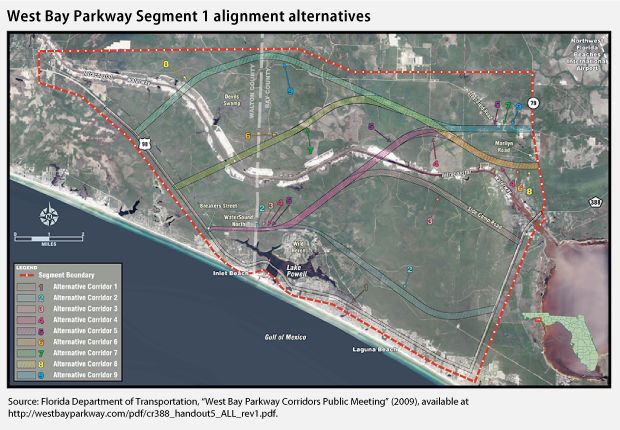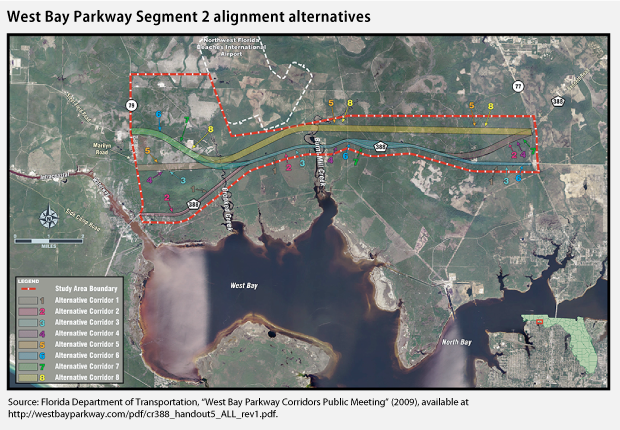Infrastructure is the foundation of America’s society and economy. Yet not all investments are worthwhile. In fact, unnecessary projects create a long-term, unproductive cost burden—a form of infrastructure overhang. The “White Elephant Watch” series profiles projects that demonstrate the failures of the current U.S. policy approach to transportation infrastructure.
Under current federal transportation policy, states are not held accountable for their investment decisions. Instead, the federal government provides states with dedicated highway money based on formulas set in law that reflect politics as opposed to local needs or potential return on investment. Under this system, states are not required to demonstrate the social, environmental, or economic value of their projects. Beyond certain procedural and design requirements, states have total discretion, which often results in projects that fail to provide clear benefits or to advance national transportation policy objectives.
The steady flow of highway funds means that even highly questionable projects can advance. Take, for example, the proposed West Bay Parkway outside of Panama City, Florida. The project has an estimated cost of $566 million. Given its location, the proposed parkway will not serve as an effective alternative route for travelers on U.S. Route 98. Moreover, alternative investments in things such as public transportation would provide far greater congestion relief at a much lower cost.
Congestion relief to nowhere
The proposed West Bay Parkway would be located to the northwest of Panama City, running approximately 25 miles from east to west. The project consists of two segments: Segment 1 would run 10 miles from State Road 79 to U.S. 98 and consist of an entirely new alignment, and Segment 2 would run 15 miles from State Road 77 to State Road 79 and involve widening the existing County Road, or CR, 388 from a two-lane rural highway to a four-lane divided rural highway.


Planners often justify new highway projects by claiming that they will relieve congestion on existing facilities. The West Bay Parkway is no exception. In this case, the Florida Department of Transportation, or FDOT, claims that the proposed parkway would provide “regional connectivity” and help “meet future traffic demand” by diverting “through traffic around Panama City and Panama City Beach.” These claims deserve some skepticism.
Let’s start with the idea that the West Bay Parkway will reduce congestion along U.S. 98 by siphoning off substantial traffic in the future. U.S. 98 is a four-lane divided highway that serves as the principal arterial roadway for Panama City and Panama City Beach. To understand where the congestion claim fails, it is first important to understand the idea of roadway level of service, or LOS. According to the Federal Highway Administration, LOS describes “a standard measurement used by transportation officials which reflects the relative ease of traffic flow on a scale of A to F, with free-flow being rated LOS-A and congested conditions rated as LOS-F.”
Somewhat counterintuitively, a lower LOS score actually corresponds to a higher level of roadway productivity. As travel speeds begin to slow, the spacing between cars is reduced and the facility can move many more vehicles per hour. For instance, a highway lane operating at LOS-A can move only 700 cars per hour, while a lane operating at LOS-E can move 2,000. In fact, LOS-E corresponds to the highest roadway productivity possible before congestion begins to substantially degrade overall performance. With these performance rules in mind, Bay County officials have set a policy goal of maintaining county roads at LOS-D or better.
As mentioned, approximately half of the proposed parkway would consist of widening CR 388 from a two-lane highway to a four-lane divided highway. If this corridor were actually an attractive or realistic alternative to U.S. 98 for area drivers, then traffic modeling would show serious congestion problems along CR 388 in future years without the widening. However, when FDOT projected out to 2035, it found that “CR 388 was not among the roads listed as failing to meet the LOS standard,” meaning that even with travel demand assumptions—pegged at 4.78 percent annually—that outstrip population growth, CR 388 still performed perfectly well without the parkway expansion. In short, CR 388 is not an effective alternative to U.S. 98 for what little through traffic the area generates—nor does it produce much local traffic.
A review of the proposed parkway corridor reveals why. Aside from a few parcels, Bay County land use maps show that within the study area for Segment 2, land is either zoned as “timberland” or “vacant acreage not zoned for agriculture.” According to FDOT, only 5,200 vehicles per day use CR 388. This averages out to just 288 vehicles per hour during the 18 daylight hours during which most people drive. This is especially telling considering that CR 388 is the only route to the Northwest Florida Beaches International Airport. FDOT attempts to sweep this inconvenient finding under the rug by stating that CR 388 is a “planned emerging SIS [Strategic Intermodal System] connector highway”—essentially a designation that reflects that planners think a few additional freight trucks might drive on it someday.
Ignoring low population growth
Next is the issue of projected travel demand growth, which rests principally on population growth. However, data from the Bureau of the Census challenge the assumptions that underpin the parkway analysis. Panama City is a modest urban center with essentially no population growth in recent years. In 2000, the city had a population of 36,417. By 2013, the population increased by just 416 people, or 1 percent, in almost a decade and a half. The entire population of Bay County, which contains Panama City and covers 758 square miles, has grown by approximately 1 percent per year since 2000. These numbers strongly suggest that Panama City and Bay County will continue to grow at a substantially lower rate than the projected travel demand growth that FDOT anticipates. As a result, the congestion growth projected by FDOT is not likely to materialize.
Public transportation alternative
Planners, however, are correct to assume some driving growth in the coming years along U.S. 98, particularly within Panama City Beach and moving east toward Panama City, as this area has experienced somewhat higher growth compared with the rest of the region. However, the real question is: What is the most cost-effective and sensible approach to address the issue?
From 2000 to 2013, the city grew by 3.5 percent per year to reach a total population of 12,064. Yet data show that it contributes mostly local traffic. Vehicle counts along U.S. 98 moving west through Panama City Beach demonstrate this point. According to data collected by FDOT, traffic volumes along U.S. 98 drop by 63 percent when the highway crosses over into Walton County. This is not surprising considering that nationally, 73 percent of all vehicle trips are less than 9 miles in length.
The estimated cost of the parkway is $566 million. To put this into perspective, a standard 40-foot city bus costs approximately $400,000. The state of Florida could purchase 1,415 city buses for what it will spend to complete the West Bay Parkway. By comparison, the Washington Metropolitan Area Transit Authority, which serves 5 million people in the Washington, D.C., region within a service area of 1,500 square miles, has a bus fleet of 1,515. In other words, Panama City and Panama City Beach could have a bus fleet equivalent to a region more than 100 times their size.
Public transportation investments are particularly attractive because traffic congestion is nonlinear, meaning that a modest reduction in the total number of vehicles traveling through a corridor could substantially improve the speed of remaining vehicles. For example, a reduction of just 5 percent in the overall traffic volumes on a congested roadway can produce an increase in average vehicle speeds of as much as 30 percent. On a roadway carrying 2,000 cars per hour, this would be a reduction of just 100 cars.
A standard 40-foot bus has a capacity of 75 passengers. Assuming a 4-minute interval between buses, or just 15 buses per hour, Bay Town Trolley, which is the public transportation provider for the region, could move a maximum of 1,125 people per hour along U.S. 98. While it’s unlikely that buses operating along U.S. 98 would hit peak capacity, the performance benefits still stand. Improved transit service would significantly improve roadway performance for pennies on the dollar compared with building the unnecessary West Bay Parkway.
The emperor has no tolls
Perhaps the most revealing finding published by FDOT was an analysis that looked at the feasibility of financing the construction of the parkway through tolling. Based on a number of assumptions, FDOT presented results assuming both high and low travel demand. Under the low-demand scenario, beginning in 2015, the completed parkway would generate 2.6 million trips. This works out to approximately 7,100 trips per day, which is an unexplained increase of 37 percent over current vehicle counts for CR 388. But the problems do not stop there. Beyond all comprehension, the analysis assumes that demand would grow at an annual rate of 9.1 percent per year for 30 years, resulting in almost 37 million trips by 2045. Under the high-demand scenario, the parkway would generate 5.2 million trips in 2015—double the low estimate but assuming the exact same population—and climb to 44.6 million in 2045. Under the high scenario, traffic in 2015 starts 174 percent higher than current counts on CR 388, again without explanation. Even with these unbelievable numbers, the report concluded that tolling the parkway would still only “generate revenues that are 16% to 47% of the project costs.”
These results should set off alarm bells. In essence, they reveal that the state is advancing an expensive project that—even under indefensible travel assumptions—would not generate enough revenue to support itself financially. Far from serving as justification, these results highlight the expense of the proposed parkway. Yet undaunted, FDOT continues to move forward.
Conclusion
The West Bay Parkway demonstrates the problem with the lack of accountability in transportation planning. When federal highway money flows on an annual basis, states are able to advance expensive, questionable projects rather than look for solutions that are far more affordable and sensible. In the future, states should be required to demonstrate how their projects will deliver social, economic, and environmental benefits. In addition, states should be required to track and report the accuracy of their travel demand forecasts. Finally, a larger share of federal funding should be distributed on a competitive basis rather than by formulas set in law. The time has come to hold states accountable for how they spend limited federal funds.
Kevin DeGood is the Director of Infrastructure Policy at the Center for American Progress.